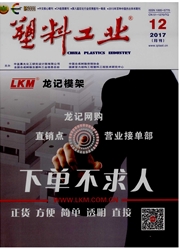

 中文摘要:
中文摘要:
研究了聚苯乙烯(PS)/碳纳米管(CNT)复合材料的结构一导电性能关系在拉伸形变下的变化并探索其原因。随着碳管含量的增加,复合材料的电导率逐渐增强,并很好符合逾渗理论,意味着碳管数量到达一定程度时碳管问彼此搭接而形成导电填料网络。而当在PS玻璃化转变温度以上(118℃)施加拉伸形变后,复合材料的导电性随着拉伸应变的增加而呈现递减趋势,且在高拉伸应变下偏离线性关系,这主要归结于拉伸取向破坏导电网络以及界面相互作用的增强阻断了碳管问相互搭接。
 英文摘要:
英文摘要:
The structure-electric conductivity relationship of polystyrene (PS)/carbon nanotube (CNT) composites during a stretching deformation process and its underlying mechanism were studied. The electric conductivity of PS/CNT nanocomposite increased gradually with the accumulating of CNT, and it was in accordance with the percolation theory, which indicated that the CNTs had mutually connected to form a conductive network at certain critical filler amount. However, the electric conductivity experienced a continuous descending when the stretching was performed above the Tg of PS, 118 ℃; meanwhile, a deviation from the linear relationship of conductivity vs strain was occurred when the strain was high. This phenomenon was mainly ascribed to orientation of carbon nanotubes and improved interfacial interaction arisen from stretching, which hindered the connection of CNTs.
 同期刊论文项目
同期刊论文项目
 同项目期刊论文
同项目期刊论文
 Enhanced crystallization behaviors of poly (ethylene terephthalate) via adding expanded graphite and
Enhanced crystallization behaviors of poly (ethylene terephthalate) via adding expanded graphite and Brittle-ductile transition behavior of poly(ethylene terephthalate)/poly(ethylene-octene) blend: the
Brittle-ductile transition behavior of poly(ethylene terephthalate)/poly(ethylene-octene) blend: the Exploring interfacial enhancement in polystyrene/multiwalled carbon nanotube monofilament induced by
Exploring interfacial enhancement in polystyrene/multiwalled carbon nanotube monofilament induced by Oscillatory shear-accelerated exfoliation of graphite in polypropylene melt during injection molding
Oscillatory shear-accelerated exfoliation of graphite in polypropylene melt during injection molding Superior toughness obtained via tuning the compatibility of poly(ethylene terephthalate)/poly(ethyle
Superior toughness obtained via tuning the compatibility of poly(ethylene terephthalate)/poly(ethyle 期刊信息
期刊信息
